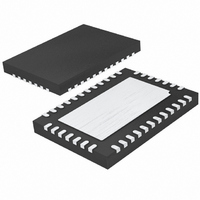LTC3576EUFE#PBF Linear Technology, LTC3576EUFE#PBF Datasheet - Page 34

LTC3576EUFE#PBF
Manufacturer Part Number
LTC3576EUFE#PBF
Description
IC POWER MANAGER W/USB OTG 38QFN
Manufacturer
Linear Technology
Datasheet
1.LTC3576EUFEPBF.pdf
(48 pages)
Specifications of LTC3576EUFE#PBF
Applications
Handheld/Mobile Devices
Voltage - Supply
4.35 V ~ 5.5 V
Operating Temperature
-40°C ~ 85°C
Mounting Type
Surface Mount
Package / Case
38-QFN
Lead Free Status / RoHS Status
Lead free / RoHS Compliant
Current - Supply
-
Available stocks
Company
Part Number
Manufacturer
Quantity
Price
APPLICATIONS INFORMATION
LTC3576/LTC3576-1
There are MLCCs available with several types of dielectrics
each having considerably different characteristics. For
example, X7R MLCCs have the best voltage and tempera-
ture stability. X5R MLCCs have apparently higher packing
density but poorer performance over their rated voltage
and temperature ranges. Y5V MLCCs have the highest
packing density, but must be used with caution, because
of their extreme nonlinear characteristic of capacitance
versus voltage. The actual in-circuit capacitance of a
ceramic capacitor should be measured with a small AC
signal and DC bias as is expected in-circuit. Many vendors
specify the capacitance versus voltage with a 1V
test signal and, as a result, over state the capacitance that
the capacitor will present in the application. Using similar
operating conditions as the application, the user must
measure or request from the vendor the actual capacitance
to determine if the selected capacitor meets the minimum
capacitance that the application requires.
Step-Down Switching Regulator Output Voltage
Programming
All three switching regulators have I
set points and can be programmed for start-up output
voltages of at least 0.8V. The full-scale output voltage for
each switching regulator is programmed using a resistor
divider from the switching regulator output connected to
the FBx pins such that:
where V
Typical values for R1 are in the range of 40k to 1M. The
capacitor C
and the input capacitance of the FBx pin and also helps
34
V
OUTx
FBx
Figure 5. Buck Converter Application Circuit
= V
FB
LTC3576-1
LTC3576/
ranges from 0.425V to 0.8V. See Figure 5.
cancels the pole created by feedback resistors
FBx
V
INx
SWx
GND
⎛
⎜
⎝
FBx
R2
R1
+ 1
L
C
⎞
⎟
⎠
FB
R1
R2
3576 F05
2
C programmable
C
OUT
V
OUTx
RMS
AC
to improve transient response for output voltages much
greater than 0.8V. A variety of capacitor sizes can be used
for C
plications. Experimentation with capacitor sizes between
2pF and 22pF may yield improved transient response.
Step-Down Switching Regulator Inductor Selection
Many different sizes and shapes of inductors are avail-
able from numerous manufacturers. Choosing the right
inductor from such a large selection of devices can be
overwhelming, but following a few basic guidelines will
make the selection process much simpler.
The general purpose step-down converters are designed to
work with inductors in the range of 2μH to 10μH. For most
applications a 4.7μH inductor is suggested for the lower
current switching regulators 1 and 2 and 2μH is recom-
mended for the higher current switching regulator 3. Larger
value inductors reduce ripple current which improves out-
put ripple voltage. Lower value inductors result in higher
ripple current and improved transient response time. To
maximize effi ciency, choose an inductor with a low DC
resistance. For a 1.2V output, effi ciency is reduced about
2% for 100mΩ series resistance at 400mA load current,
and about 2% for 300mΩ series resistance at 100mA load
current. Choose an inductor with a DC current rating at
least 1.5 times larger than the maximum load current to
ensure that the inductor does not saturate during normal
operation. If output short circuit is a possible condition,
the inductor should be rated to handle the maximum peak
current specifi ed for the step-down converters. Different
core materials and shapes will change the size/current
and price/current relationship of an inductor. Toroid or
shielded pot cores in ferrite or Permalloy materials are
small and don’t radiate much energy, but generally cost
more than powdered iron core inductors with similar
electrical characteristics. Inductors that are very thin or
have a very small volume typically have much higher
core and DCR losses, and will not give the best effi ciency.
The choice of which style inductor to use often depends
more on the price vs size, performance and any radiated
EMI requirements than on what the LTC3576/LTC3576-1
require to operate.
FB
but a value of 10pF is recommended for most ap-
3576fb













